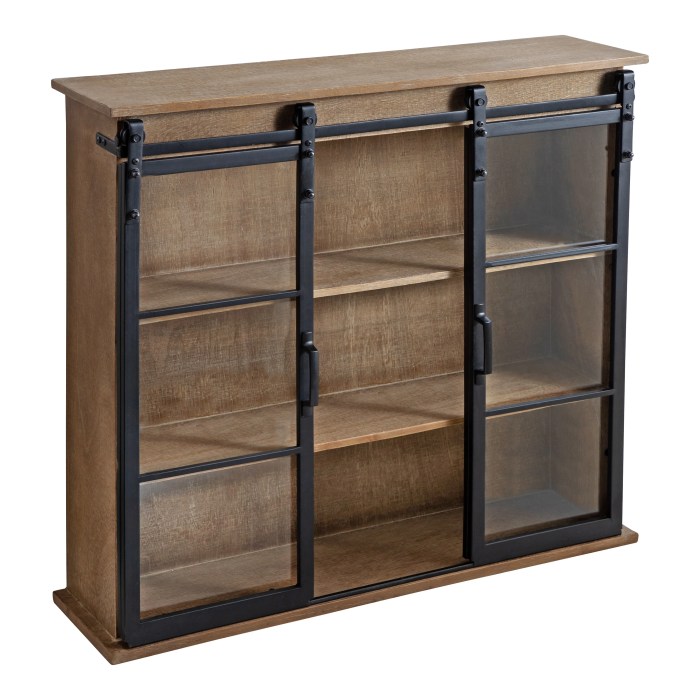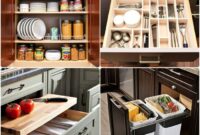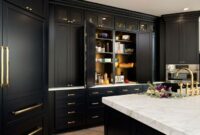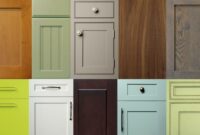Sliding door cabinets offer a stylish and practical approach to storage, maximizing space and enhancing the aesthetic appeal of any room. From sleek, modern designs to more traditional styles, these cabinets provide a versatile solution for kitchens, bedrooms, bathrooms, and more. This guide explores the various types, installation processes, design considerations, and cost factors associated with sliding door cabinets, helping you make an informed decision for your home.
We’ll delve into the differences between bypass, pocket, and barn door systems, examining their functionality and suitability for different spaces. We’ll also cover the importance of choosing the right materials, finishes, and internal organization systems to optimize both storage and visual impact. Whether you’re considering a pre-assembled unit or a custom-designed masterpiece, this comprehensive guide will equip you with the knowledge you need.
Types of Sliding Door Cabinets
Sliding door cabinets offer a space-saving and stylish alternative to traditional hinged doors, enhancing both functionality and aesthetics in various rooms. Their versatility in design and material allows for seamless integration into diverse interior styles, from modern minimalism to rustic charm. This section explores the different types available, their features, and considerations for optimal placement within your home.
Types of Sliding Door Cabinets: Material and Style
The market offers a wide variety of sliding door cabinets, each distinguished by its material and style. The choice depends largely on personal preference, budget, and the overall design theme of the room.
| Type | Material | Style | Common Uses |
|---|---|---|---|
| Bypass Sliding Doors | Wood (solid wood, veneer, MDF), Metal (aluminum, steel), Glass (tempered, frosted), Laminate | Modern, Traditional, Rustic, Contemporary | Closets, Pantries, Media Centers, Bathrooms |
| Pocket Sliding Doors | Wood (MDF, plywood), Metal (aluminum) | Modern, Minimalist | Closets, Office Spaces, Bedrooms |
| Barn Door Sliding Cabinets | Wood (reclaimed wood, pine, oak), Metal (steel, wrought iron) | Rustic, Farmhouse, Industrial | Closets, Bathrooms, Kitchens (as pantry doors) |
| Frameless Sliding Doors | Glass (tempered, frosted), Wood veneer | Modern, Minimalist | Closets, Bathrooms, Showcases |
Functionality of Different Sliding Door Systems
Understanding the differences between bypass, pocket, and barn door systems is crucial for selecting the best option for your needs.Bypass sliding doors use two or more panels that slide past each other along a track.
Sliding door cabinets are a great space-saving solution for kitchens, especially in smaller spaces. If you’re looking for a truly personalized design, consider incorporating them into your custom kitchen setup. Check out the options available for Custom Kitchen Cabinets to see how you can integrate sliding doors into your dream kitchen. The sleek lines of sliding doors can really elevate the overall look of your sliding door cabinets.
- Advantages: Space-saving, versatile, suitable for various materials.
- Disadvantages: Requires sufficient wall space for sliding, can be more expensive than other systems for larger units.
Pocket sliding doors retract into the wall cavity, completely disappearing when open.
- Advantages: Maximizes space, provides a clean, uncluttered look.
- Disadvantages: Requires wall cavity space for the doors to recess into, can be more complex to install.
Barn door sliding cabinets use a single panel that slides along a track mounted on the wall.
- Advantages: Rustic appeal, easy installation, relatively inexpensive.
- Disadvantages: Can take up some floor space when open, not ideal for narrow spaces.
Design Considerations for Different Room Types
The choice of sliding door cabinet should complement the room’s style and function.In kitchens, consider durability and easy cleaning. Materials like laminate or easy-to-wipe wood are ideal. Bypass or pocket doors work well, maximizing space in often-crowded areas.Bedrooms often benefit from space-saving pocket doors or stylish barn doors that add a touch of rustic charm. Material choices might include wood veneers or painted MDF for a clean, modern look.Bathrooms require moisture-resistant materials like glass or sealed wood.
Bypass or pocket doors are practical to avoid swinging doors that could bump into fixtures. Consider frosted glass for privacy.
Installation and Maintenance
Installing and maintaining sliding door cabinets ensures their longevity and smooth operation. Proper installation prevents future problems, while regular maintenance keeps them running smoothly for years to come. This section provides a detailed guide for both processes.
Installing Sliding Door Cabinets: A Step-by-Step Guide
Careful planning and execution are crucial for a successful installation. The following steps Artikel a typical installation process, but always refer to your specific cabinet’s instructions. Safety should always be your top priority.
- Preparation: Gather necessary tools including a stud finder, level, drill, screwdriver (Phillips and flathead), measuring tape, pencil, safety glasses, and appropriate screws and anchors for your wall type. Ensure the wall is structurally sound enough to support the weight of the cabinet. Carefully read the manufacturer’s instructions.
- Marking and Mounting the Tracks: Use the stud finder to locate wall studs. Mark the positions for the top and bottom tracks on the wall, ensuring they are level using a level. Pre-drill pilot holes to prevent the wood from splitting, and securely attach the tracks to the wall studs using appropriate screws. If installing on drywall, use wall anchors for extra security.
Sliding door cabinets offer a space-saving solution for smaller rooms. If you’re aiming for a cozy, farmhouse feel, consider pairing them with a rustic aesthetic; check out these beautiful options for Rustic cabinets to complement your sliding door design. The combination of modern convenience and rustic charm can create a truly unique look for your home.
- Hanging the Cabinet: Carefully lift the cabinet and slide the top track onto the mounted top track on the wall. Ensure it’s level and properly aligned. Then, attach the bottom track to the cabinet, ensuring it aligns with the bottom track mounted on the wall.
- Door Installation: Attach the sliding doors to the cabinet according to the manufacturer’s instructions. This often involves hanging the doors on rollers that fit into the tracks. Make sure the doors slide smoothly and effortlessly.
- Testing and Adjustments: Test the sliding mechanism to ensure the doors move smoothly and quietly. Make any necessary adjustments to the tracks or rollers to correct any sticking or misalignment. Ensure the doors close completely and securely.
Maintaining Sliding Door Cabinets: Tips and Techniques
Regular maintenance prevents common problems and extends the life of your sliding door cabinets. Addressing minor issues promptly prevents them from becoming major problems.
Sliding door cabinets are a great space-saving solution for any room. If you’re looking for truly customized storage, though, consider the options available through Bespoke Cabinetry Services ; they can create sliding door cabinets perfectly tailored to your needs and style, ensuring a seamless fit and maximizing your space. From sleek modern designs to more traditional styles, the possibilities are endless with bespoke cabinetry.
Sticking or derailment are common issues. These often result from dust, debris, or a lack of lubrication. To prevent this, regularly clean the tracks and rollers.
- Regular Cleaning: Use a soft cloth or brush to remove dust and debris from the tracks and rollers. A vacuum cleaner with a brush attachment can be helpful. For stubborn dirt, use a slightly damp cloth and mild detergent, ensuring it’s thoroughly dried afterwards.
- Lubrication: Apply a small amount of silicone-based lubricant to the rollers and tracks. Avoid using oil-based lubricants as they can attract dust and dirt. This helps ensure smooth movement and prevents sticking.
- Tightening Screws: Periodically check all screws and tighten any that have become loose. Loose screws can cause misalignment and affect the smooth operation of the sliding doors.
- Addressing Misalignment: If the doors become misaligned, carefully adjust the rollers or tracks to correct the problem. Refer to the manufacturer’s instructions for specific adjustment procedures.
Sliding Door Cabinet Maintenance Schedule, Sliding door cabinets
A simple maintenance schedule helps prevent problems and keeps your cabinets in top condition.
| Task | Frequency | Method |
|---|---|---|
| Cleaning (dusting/vacuuming tracks and rollers) | Monthly | Soft brush, vacuum cleaner with brush attachment |
| Lubrication (silicone-based lubricant) | Every 3-6 months | Apply sparingly to rollers and tracks |
| Inspection (check for loose screws, misalignment) | Annually | Visually inspect, tighten loose screws, adjust rollers if needed |
Design and Aesthetics
Sliding door cabinets offer a unique blend of functionality and aesthetic appeal, significantly impacting a room’s overall design. The careful selection of handle styles, finishes, and colors can transform a simple storage solution into a striking design feature. Consideration of the cabinet’s integration with the existing interior design scheme is crucial for achieving a cohesive and visually pleasing space.The impact of handle styles and finishes on the overall aesthetic of sliding door cabinets is considerable.
Subtle details can dramatically alter the perception of the cabinet and the room.
Handle Styles and Finishes
Handleless designs create a sleek, minimalist look, ideal for modern or contemporary settings. Recessed handles offer a similar clean aesthetic, while protruding bar handles add a touch of industrial chic or traditional elegance depending on the material and finish. For example, brushed nickel handles lend a modern feel, while antique brass handles contribute to a more traditional ambiance.
The choice of finish – matte, gloss, brushed, or polished – further influences the overall visual impact, with matte finishes offering a softer, more understated look, while gloss finishes reflect light and create a sense of sophistication.
Sliding Door Cabinets in Various Interior Design Styles
The versatility of sliding door cabinets allows for seamless integration into diverse interior design styles.
- Modern: Clean lines, minimalist hardware (or handleless designs), and neutral color palettes (white, grey, black) are key. Imagine sleek, high-gloss white cabinets with integrated lighting, enhancing the minimalist aesthetic.
- Traditional: Ornate detailing, raised panel doors, and darker wood finishes (cherry, walnut) are characteristic. Picture cabinets with detailed molding, antiqued brass knobs, and a rich, dark stain.
- Minimalist: Simplicity and functionality are paramount. Handleless cabinets in neutral colors (off-white, light grey) with a seamless integration into the wall create a clutter-free look. Consider a light grey cabinet that blends seamlessly with the wall, enhancing the feeling of spaciousness.
- Rustic: Natural wood finishes (reclaimed wood, oak), visible wood grain, and simple hardware are typical. Visualize cabinets made from reclaimed barn wood with simple, wrought iron handles, creating a cozy, natural feel.
- Contemporary: A blend of modern and traditional elements. Consider cabinets with clean lines but incorporating subtle metallic accents (such as brushed gold or copper handles) and textured finishes. Imagine sleek black cabinets with brushed gold handles, a stylish combination of modern and luxurious elements.
Popular Color Options for Sliding Door Cabinets
The color of sliding door cabinets significantly influences the overall mood and feel of a room.
- White: A classic choice, white cabinets brighten up any space and create a sense of airiness, suitable for smaller rooms or those lacking natural light.
- Grey: A versatile neutral, grey cabinets offer a sophisticated and calming atmosphere, working well in both modern and traditional settings.
- Black: Black cabinets create a dramatic and bold statement, ideal for adding a touch of elegance to a room. However, they can make a small room feel smaller.
- Natural Wood Tones: Oak, cherry, and walnut offer warmth and texture, creating a cozy and inviting atmosphere, particularly well-suited to rustic or traditional styles.
- Navy Blue: A rich and sophisticated color, navy blue cabinets add depth and personality to a room. This is an excellent choice for adding a pop of color in a neutral space.
Space Optimization and Functionality
Sliding door cabinets offer a significant advantage over traditional hinged door cabinets, particularly in maximizing space utilization within a room. Their design, which eliminates the outward swing of doors, allows for placement in tighter spaces and closer to walls, maximizing usable floor area. This is especially beneficial in smaller apartments, hallways, or rooms with limited space. The efficient use of space translates directly into a more open and less cluttered feeling.Sliding doors contribute to a more efficient use of space by eliminating the “swing space” required by hinged doors.
This means that you can place furniture and other items closer to the cabinet without hindering access. For example, a hinged door cabinet might require a clear 3-foot radius to open fully, whereas a sliding door cabinet of the same size could be placed directly against a wall. This difference in usable floor space can be substantial in smaller living areas.
Internal Organization Systems for Sliding Door Cabinets
Effective internal organization is crucial for maximizing the storage efficiency of sliding door cabinets. Strategic placement of shelves, drawers, and other organizational tools allows for customized storage solutions tailored to individual needs. Deep drawers, for example, are ideal for storing bulky items like blankets or sweaters, while adjustable shelves accommodate items of varying heights. Consider using dividers within drawers to keep smaller items separated and organized.
Sliding door cabinets offer a sleek, space-saving solution for many storage needs. If you’re looking for something a bit more upscale, consider the sophisticated designs available in Luxury Display Cabinets , which often incorporate similar sliding mechanisms for a premium look. Ultimately, whether you choose a simple sliding door cabinet or a more luxurious option depends on your budget and desired aesthetic.
Customizable interior configurations are readily available for many sliding door cabinet models, ensuring optimal use of the available space.
Storage Capacity Comparison Across Different Sliding Door Cabinet Configurations
The storage capacity of sliding door cabinets varies significantly depending on their configuration. Single-door units naturally offer less storage space than double-door units, which in turn have less capacity than multiple-unit configurations where several cabinets are joined together to create a larger storage wall. A single-door unit might be suitable for a small entryway, while a double-door unit could accommodate a larger wardrobe.
Multiple-unit systems, often used in walk-in closets or home offices, provide expansive storage for a vast array of items. The choice of configuration directly impacts the overall storage capacity and should be aligned with the specific storage needs and the available space in the room. For instance, a small apartment might benefit from a compact single-door unit, while a larger home could accommodate a multi-unit system to create a large, organized storage area.
Cost and Considerations

Source: walmartimages.com
Choosing sliding door cabinets involves careful consideration of various factors, most significantly cost. The initial investment can vary widely depending on several key elements, and understanding these will help you make an informed decision that aligns with your budget and long-term needs. This section will explore the factors affecting cost and highlight the long-term value of investing in high-quality cabinets.The price of sliding door cabinets is influenced by a complex interplay of materials, size, and customization.
Higher-end materials like solid wood or high-quality veneers will naturally command a higher price than more budget-friendly options such as particleboard or medium-density fiberboard (MDF). Similarly, larger cabinets require more materials and labor, leading to increased costs. Custom designs, involving intricate details or non-standard dimensions, will also add to the overall expense. Finally, the choice of hardware, such as the type of sliding mechanism and handles, can also impact the final price.
Factors Influencing Sliding Door Cabinet Costs
Several key factors contribute to the overall cost. Material selection plays a significant role, with solid wood being the most expensive, followed by veneers, and then MDF or particleboard. Cabinet size directly impacts cost; larger units require more materials and labor. Customization options, such as unique finishes, intricate carvings, or bespoke internal configurations, increase the cost substantially. The type of sliding mechanism, from simple roller systems to more sophisticated soft-close mechanisms, also affects the final price.
Finally, the level of installation complexity, such as needing significant modifications to existing structures, can increase labor costs.
Long-Term Cost Benefits of High-Quality Cabinets
Investing in high-quality sliding door cabinets offers significant long-term cost benefits. Durable materials and robust construction ensure longevity, reducing the need for frequent replacements or repairs. High-quality sliding mechanisms operate smoothly and quietly for years, minimizing maintenance needs. Superior finishes are more resistant to scratches and damage, maintaining their aesthetic appeal for a longer period. This translates to lower overall costs over the lifespan of the cabinets compared to cheaper alternatives that might require repairs, replacements, or refinishing sooner.
For example, a solid wood cabinet might cost significantly more upfront, but its resilience and longevity could easily offset the higher initial investment over 15-20 years compared to a particleboard cabinet needing replacement within 5-7 years.
Cost Comparison Table
The following table provides a general price range for different types and materials of sliding door cabinets. Note that these are estimates and actual prices may vary depending on location, retailer, and specific customizations.
| Cabinet Type | Material | Size (Approximate) | Price Range |
|---|---|---|---|
| Standard Wardrobe | MDF | 6ft | $300 – $700 |
| Custom Wardrobe | Veneer | 8ft | $800 – $1500 |
| Luxury Wardrobe | Solid Wood | 10ft | $1500 – $4000+ |
| Media Cabinet | MDF | 4ft | $200 – $500 |
Custom Sliding Door Cabinets
Choosing between pre-assembled and custom-made sliding door cabinets involves weighing several factors. Pre-assembled units offer convenience and affordability, while custom cabinets provide unparalleled personalization and a perfect fit for your space and style. This section explores the advantages and disadvantages of each, highlighting the design possibilities and considerations involved in creating bespoke sliding door cabinetry.Custom-made sliding door cabinets offer a level of personalization unavailable with pre-assembled options.
This allows for complete control over design, materials, and functionality, ensuring the cabinets perfectly integrate with your existing décor and storage needs. However, this level of customization comes at a higher cost and longer lead time compared to readily available units.
Advantages and Disadvantages of Custom vs. Pre-assembled Cabinets
The decision between custom and pre-assembled cabinets hinges on your priorities. Pre-assembled cabinets are readily available, often cheaper, and require less time for installation. However, they offer limited customization options, potentially leading to compromises in design or functionality to fit existing sizes and styles. Conversely, custom cabinets offer complete design flexibility, allowing for unique features and a perfect fit, but they involve higher costs and longer lead times.
The ideal choice depends on your budget, timeline, and the level of customization required.
Custom Design Features for Sliding Door Cabinets
Custom sliding door cabinets open up a world of design possibilities. Beyond basic size and material selection, you can incorporate features that enhance both aesthetics and functionality.
Sliding door cabinets are a great space-saver, especially in smaller garages. If you need more robust storage, though, consider upgrading to the heavy-duty options available from Premium Garage Storage Cabinets ; they offer superior durability and organization. Then, you can choose sliding doors or traditional hinged doors to best suit your needs and the style of your garage.
- Mirrored Doors: Mirrored doors not only add a touch of elegance but also visually enlarge the space, making rooms feel more open and airy. A full-length mirror on a sliding door cabinet in a bedroom or hallway is a particularly practical and stylish choice.
- Integrated Lighting: Subtle, integrated lighting within the cabinet frames or behind the shelves creates a sophisticated ambiance and improves visibility inside the cabinet. LED strip lighting is a popular and energy-efficient choice.
- Specialized Storage Solutions: Custom cabinets can incorporate specialized storage solutions tailored to specific needs. This could include pull-out drawers for shoes, adjustable shelving for dishes, or pull-down pantries for easy access to items stored high up. Consider features like built-in jewelry trays, tie racks, or even integrated ironing boards depending on the intended use of the cabinets.
Working with Cabinet Makers
Collaborating effectively with a cabinet maker is crucial for achieving your desired outcome. Clear communication is key.
- Detailed Planning: Begin with detailed measurements of the space and a clear vision of your desired design. Include sketches, photos, and detailed specifications of desired materials, finishes, and features. Consider using 3D design software to visualize the final product.
- Material Selection: Discuss various materials and their pros and cons. Consider factors such as durability, cost, and aesthetics. Explore options such as wood types, veneers, laminates, and high-pressure laminates (HPL).
- Budget and Timeline: Establish a clear budget and realistic timeline upfront. Discuss potential cost overruns and delays. Get a detailed quote that includes all aspects of the project, from design and material costs to installation and any additional features.
- Contract and Communication: Sign a detailed contract that Artikels all agreed-upon specifications, payment terms, and timelines. Maintain regular communication with the cabinet maker throughout the process to address any questions or concerns promptly.
Closure
Ultimately, the choice of sliding door cabinets hinges on a careful consideration of your individual needs and preferences. By understanding the various types, installation processes, design options, and cost implications, you can select a solution that perfectly complements your home’s style and maximizes your storage potential. From enhancing space efficiency to adding a touch of modern elegance, sliding door cabinets offer a compelling blend of form and function, making them a worthwhile investment for any homeowner.
Answers to Common Questions
Can sliding door cabinets be used in humid environments like bathrooms?
Yes, but choose moisture-resistant materials like certain treated woods or aluminum frames to prevent warping or damage.
How much weight can a typical sliding door cabinet hold?
This varies greatly depending on the cabinet’s construction and size. Check the manufacturer’s specifications for weight limits.
What if my sliding door cabinet gets stuck?
Check for obstructions, clean the tracks, and lubricate the rollers with silicone spray. If the problem persists, consult a professional.
Are sliding door cabinets difficult to install?
Installation complexity depends on the type and complexity of the cabinet. Some are relatively easy DIY projects, while others require professional installation.
How often should I clean my sliding door cabinets?
Regular dusting is sufficient. For deeper cleaning, use a damp cloth and mild detergent, avoiding harsh chemicals.



